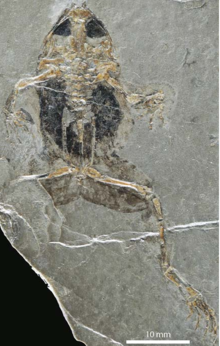Eodiscoglossus
| Eodiscoglossus Temporal range: Early Cretaceous,
| |
|---|---|

| |
| Holotype specimen of E. santonjae | |
| Scientific classification | |
| Domain: | Eukaryota |
| Kingdom: | Animalia |
| Phylum: | Chordata |
| Class: | Amphibia |
| Order: | Anura |
| Genus: | †Eodiscoglossus Villalta, 1957 |
| Type species | |
| Eodiscoglossus santonjae Villalta, 1957
| |
| Other species | |
| |
Eodiscoglossus is an extinct genus of prehistoric frogs. It is known from the type species E. santonjae from the Early Cretaceous (Barremian) La Pedrera de Rúbies Formation and El Castellar Formation of Spain, as well as a referred species E. oxoniensis known from the Forest Marble Formation of the UK[1][2][3] and an indeterminate species from the Dzunbain Formation of Mongolia.[4] It was a small primitive frog, with a length of only 27 mm (1.1 in) from the premaxilla to the ischium.[2] Formerly considered to be closely related to discoglossids, E. santonjae is now regarded as close to the root of the crown group of modern frogs[3] in a position more derived than New Zealand frogs and tailed frogs, but more basal than costatans like alytids and other more advanced frogs like neobatrachians. The morphology of E. santonjae suggests a generalist and unspecialised movement habit.[5] The referral of E. oxoniensis to Eodiscoglossus has been questioned, as it is much earlier than the type species and it is based on homoplasic and plesiomorphic characteristics inherited from a common ancestor, so there is no clear evidence of a close relation.[6]
See also
[edit]References
[edit]- ^ "†Eodiscoglossus Villalta 1957". Paleobiology Database. Fossilworks. Retrieved 17 December 2021.
- ^ a b Hecht, Max K. (1970). "The morphology of Eodiscoglossus, a complete Jurassic frog". American Museum Novitates (2424): 1–17. hdl:2246/2634.
- ^ a b Báez, Ana Maria; Gómez, Raúl O. (2016). "Revision of the skeletal morphology of Eodiscoglossus santonjae, an Early Cretaceous frog from northeastern Spain, with comments on its phylogenetic placement". Fossil Imprint. 72 (1–2): 67–77. doi:10.14446/fi.2016.67. hdl:11336/60180. ISSN 2533-4069.
- ^ Shishkin M. A. (2000) Mesozoic amphibians from Mongolia and the Central Asiatic republics, The Age of Dinosaurs in Russia and Mongolia, 297-308
- ^ Gómez, Raúl O.; Lires, Andres I. (October 2019). "High ecomorphological diversity among Early Cretaceous frogs from a large subtropical wetland of Iberia". Comptes Rendus Palevol. 18 (7): 711–723. Bibcode:2019CRPal..18..711G. doi:10.1016/j.crpv.2019.07.005. hdl:11336/148671.
- ^ Báez, Ana M.; Gómez, Raúl O. (2019). "Redescription of the overlooked basal frog Wealdenbatrachus reveals increased diversity among Early Cretaceous anurans". Cretaceous Research. 99: 14–29. Bibcode:2019CrRes..99...14B. doi:10.1016/j.cretres.2019.02.006. S2CID 133867438.
